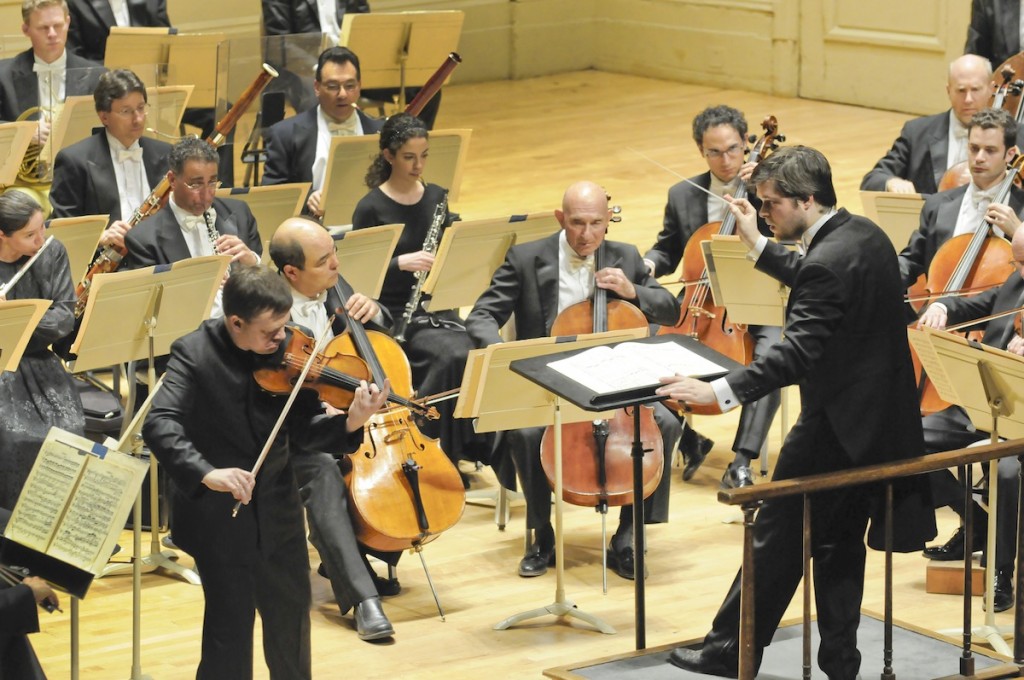Zimmermann returns for engaging and impeccable Dvořák with the BSO

Frank Peter Zimmermann performs the Dvořák Violin Concerto with Juraj Valcuha leading the Boston Symphony Orchestra Thursday night at Symphony Hall. Photo: Stu Rosner
Usually, it turns out to be a seasoned conductor who often leads a young soloist in a debut with a major orchestra.
Thursday evening at Symphony Hall, however, the roles were reversed with violinist Frank Peter Zimmermann as soloist and conductor Juraj Valcuha making his Boston Symphony Orchestra debut. The well-balanced program offered the Dvořák Violin Concerto, Kodály’s Dances of Galánta, and the Mendelssohn Scottish symphony (No. 3).
Zimmermann, at 47, is certainly no grizzled warrior. But he did make his BSO debut nearly 25 years ago, and since then has performed almost a dozen different concertos with the orchestra. He is clearly well respected by the ensemble, and deservedly so.
Valcuha, on the other hand, has had relatively few appearances in America, but the Russian-trained Slovak has impressive European credentials. For this tricky and unusual concerto, the pairing with Zimmermann was fortuitous.
The concerto has a somewhat uneven structure that cannot mask its infectious musical beauties. After a brief tutti opening, the soloist launches unexpectedly into a cadenza—just a few measures into the piece. Throughout the first movement there is no statement-development-recapitulation in the traditional manner; instead, it moves restlessly from one idea to the next, sometimes linked, sometimes not.
Zimmermann’s presence was felt most keenly here, not just in executing the solo part, but in his partnership with Valcuha. Interpretively, Zimmermann occupies a space somewhere between the impetuous agility of Gil Shaham and the cool potency of Joshua Bell. He lets the music inspire him, but is careful not to upstage his fellows with onstage gyrations. His tone was impeccable, and his instrument, a 1711 Strad that once belonged to Kreisler, has colors well suited to Dvořák’s sonic palette.
Valcuha’s control wasn’t always airtight; the conductor drew alert playing in the string sections, but some slackness further back, especially some atypical squalling by the brass in the second theme of the final movement.
Valcuha proved equally mixed in the rest of the program, veering from skillful leadership to over-aggressiveness. Kodály’s Dances, a gorgeous tribute to his Gypsy roots and the music he heard growing up in Galánta, a small town in Hungary, was served up with finesse. Valcuha negotiated the rhythmic terrain—mostly straightforward with some syncopation—in an understated manner, accenting the folksy, klezmer-inflected style. Extended filigree lines from principal clarinetist William Hudgins were central to establishing the gypsy feel.
Mendelssohn’s Symphony No. 3 was taken at far too brisk a tempo, especially in the first movement, and was also much too loud. Anyone not knowing the piece would have been hard put to guess this came from the delicate muse of Mendelssohn. By the time Valcuha reached the second movement Scherzo assai vivace, there was hardly any way to distinguish it from the first movement Allegro agitato.
Valcuha settled down, however, in the third movement abandoning his baton and moulding the Adagio cantabile with great consideration. The finale lent the requisite payoff—especially the surprise introduction of a new melody, which brings the work to its conclusion—drawn out in sharp relief.
The program will be repeated 1:30 p.m. Friday and 8 p.m. Saturday. bso.org; 617-266-1492.
Posted in Performances